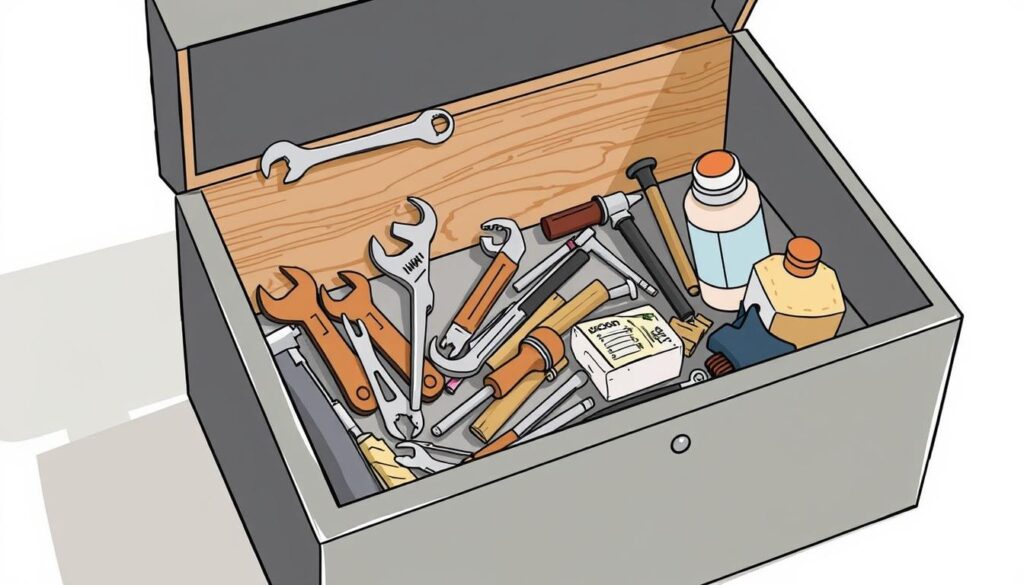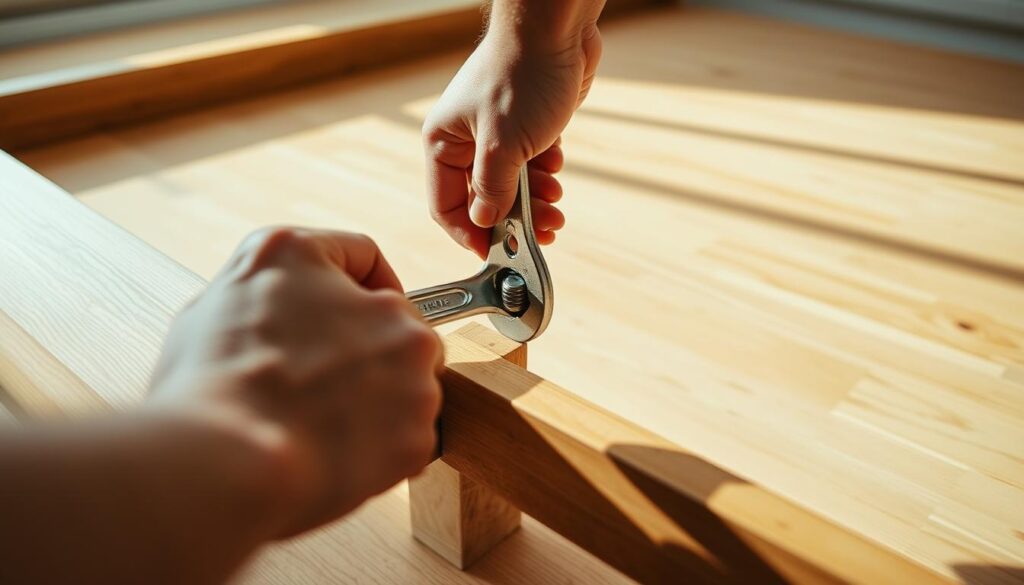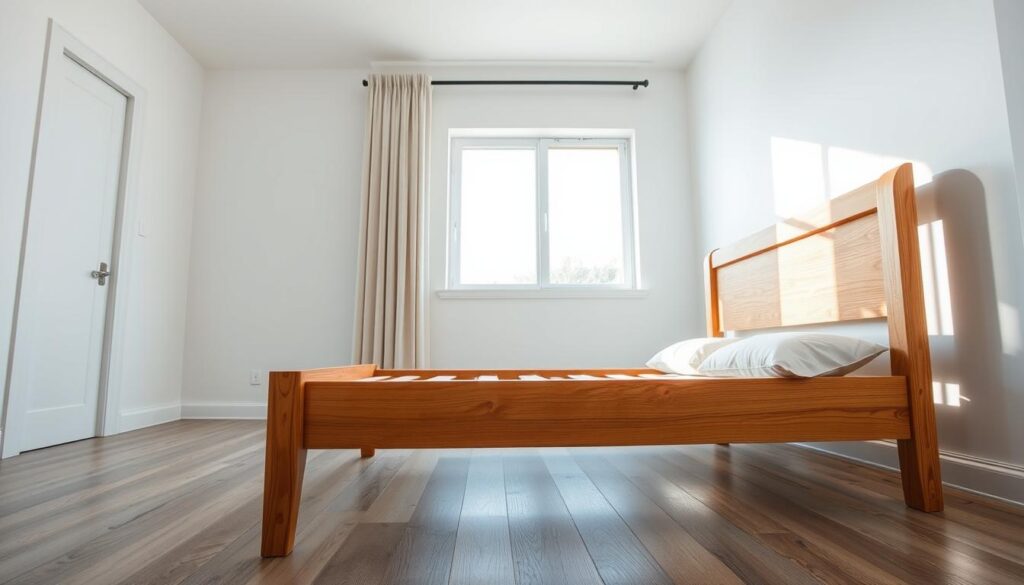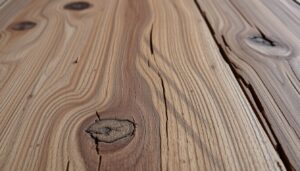Are you tired of a creaky bed frame disrupting your sleep? A sturdy bed is essential for a good night’s rest, but over time, the joints can become loose, leading to annoying squeaks and a compromised sleeping surface.
Regularly checking and maintaining your frame can help prevent such issues. By tightening loose connections, you can extend the life of your bed and improve your overall sleep quality.
Key Takeaways
- Identify and fix loose joints to ensure a stable sleeping surface.
- Understand why bed frame joints become loose over time.
- Learn the essential tools needed for tightening different types of connections.
- Follow step-by-step instructions to successfully tighten loose joints.
- Improve your overall sleep experience by maintaining your bed frame.
Why Bed Frames Become Loose and Wobbly
It’s common for bed frames to loosen as they age, but understanding the reasons behind this can help you address the problem. A bed frame that becomes loose can be frustrating and may lead to further issues if not addressed promptly.
Common Causes of Loose Joints
Several factors contribute to a bed frame becoming loose over time. Regular use is a primary cause, as nightly movements can cause gradual wear on connection points and fasteners. Additionally, uneven weight distribution can accelerate loosening in specific areas of the frame. Environmental factors, such as changes in humidity, can also cause wooden components to expand and contract, loosening joints and connections.
- Poor initial assembly can lead to weak points that quickly deteriorate.
- The quality of materials used in the bed frame significantly impacts its longevity.
- Cheaper bed frames often use lower-grade hardware that’s more prone to loosening.
Signs Your Bed Frame Needs Attention
Identifying the signs of a loose bed frame is crucial to addressing the issue early. Visible gaps at connection points, excessive movement when sitting on the bed, and the development of squeaks or creaks during normal use are all indicators that your frame needs attention. A properly functioning bed frame should feel solid when you press down on different areas, with no noticeable give or movement at the joints.
By addressing loose joints early, you can prevent more serious structural issues that could compromise the frame’s integrity and potentially damage your mattress.
Essential Tools for Tightening Bed Frame Joints

When it comes to tightening loose bed frame joints, having the right tools is crucial for a successful repair. You’ll need a variety of tools depending on the type of fasteners used in your bed frame.
Basic Tools Every Homeowner Should Have
To start, you’ll need some basic tools that every homeowner should have. A quality multi-bit screwdriver set is essential for tightening various screw types found in bed frames. Allen wrenches (hex keys) are also crucial as many modern bed frames use hex bolts for their primary connections. An adjustable spanner or wrench set will help you tackle nuts and bolts of different sizes.
Pliers can be invaluable for reaching awkward angles and providing extra leverage when tightening stubborn fasteners in your bed frame.
Optional Specialised Tools for Different Frame Types
For wooden bed frames with loose joints, you’ll need wood glue to reinforce the connection. Clamps may be required to hold the joint in place while the glue dries. For metal bed frames, you may need to replace or add metal brackets or strapping at the joints to reinforce the structure. Specialised tools such as thread-locking adhesive can prevent bolts from loosening over time.
Consider investing in felt pads or rubber washers to place between metal components, which can reduce friction and prevent squeaking when the bed frame moves.
Tightening Loose Bed Frame Joints: Step-by-Step Process
Tightening loose bed frame joints is a straightforward process that requires some basic tools and patience. To start, you need to prepare your workspace and identify the loose connections.
Preparing Your Workspace
Begin by completely stripping the bed of all bedding, mattress, and if applicable, the box spring to gain full access to the frame structure. Create adequate working space around the bed frame by moving nearby furniture, ensuring you have room to manoeuvre tools and access all sides of the frame. Gather all necessary tools before starting to avoid interruptions during the repair process.
Identifying Loose Connections
Methodically inspect each joint and connection point, paying special attention to areas where you’ve noticed movement or heard squeaking during use. Test for looseness by gently rocking different parts of the frame and noting where movement occurs.
Tightening Screws, Bolts and Nuts
Use a screwdriver or wrench to tighten screws, bolts, and nuts on the bed frame. Work in a cross-pattern to ensure even pressure distribution and prevent warping. Be careful not to overtighten fasteners, especially in wooden frames. For persistently loose connections, consider using thread-locking adhesive on metal components or wood glue for wooden joints.
- Strip the bed of all bedding and accessories to access the frame.
- Clear the area around the bed to manoeuvre tools easily.
- Gather necessary tools like screwdrivers and wrenches.
- Inspect each joint and connection point methodically.
- Tighten screws, bolts, and nuts in a cross-pattern.

After tightening all connections, test the stability of the frame by applying pressure to different areas and listening for any remaining squeaks or creaks. Reassemble the bed completely and test it by sitting and lying on different areas to ensure all loose joints have been properly addressed.
Fixing Wooden Bed Frame Joints
Wooden bed frames are prone to damage, particularly at joints and stress points, requiring timely repairs to maintain their durability. Over time, the wood can crack or split, compromising the structural integrity of your bed frame.
When dealing with cracked or split wood, the first step is to inspect the damage carefully. Determine if it’s a surface issue or a deeper structural problem. For hairline cracks, applying a high-quality wood glue and clamping until dry can be sufficient. More significant splits may require you to gently pry the crack open to allow the glue to penetrate deeply before clamping.
Repairing Cracked or Split Wood
To repair cracked or split wood, start by cleaning the area around the crack to remove any debris or dust. Then, liberally apply wood glue inside the crack. Use clamps to hold the cracked section together tightly, wiping away any excess glue. Let it dry for at least 24 hours. For added strength, consider reinforcing the repair with a piece of plywood or a metal brace.
Reinforcing Weak Wooden Joints
Weak wooden joints can be reinforced with corner braces or L-brackets, providing extra support at vulnerable connection points. For loose mortise and tenon joints, disassemble the joint, clean old glue residue, apply fresh wood glue, and clamp until fully cured. Bed slats that have weakened can be reinforced by gluing and screwing a same-width piece of plywood to the underside, creating a stronger composite structure.
By following these steps, you can effectively repair and reinforce your wooden bed frame, ensuring it remains sturdy and durable for years to come.
Addressing Metal Bed Frame Issues
Unlike wooden bed frames, metal bed frames often suffer from bent metal parts and loose fasteners, necessitating different repair approaches. When dealing with metal bed frames, it’s essential to understand the common issues that arise and how to address them effectively.
Dealing with Bent Metal Parts
Bent metal components are a frequent problem with metal bed frames. To fix these issues, you first need to assess the damage to determine the extent of the bending and whether the part can be straightened or needs replacement.
For minor bends in non-critical areas, you can use pliers or an adjustable wrench to gently bend the metal back into its original position. However, for more significant bends, especially in load-bearing parts, it’s advisable to place a wooden block against the metal to distribute the force evenly before carefully hammering it back into shape.
Using Thread-locking Adhesives for Metal Frames
Loose screws or bolts are another common issue with metal bed frames. To prevent these fasteners from coming loose over time, consider applying a thread-locking adhesive. This type of adhesive secures the fasteners in place without making them permanent, allowing for future disassembly if needed.
When applying thread-locking adhesive, ensure that you clean the threads thoroughly with isopropyl alcohol first. Then, apply the adhesive sparingly to the male threads only, following the manufacturer’s instructions.
| Issue | Solution | Tools Required |
|---|---|---|
| Bent metal parts | Assess damage, then bend or replace | Pliers, adjustable wrench, hammer, wooden block |
| Loose screws or bolts | Apply thread-locking adhesive | Thread-locking adhesive, isopropyl alcohol |
Solving Common Bed Frame Problems
A sturdy bed frame is essential for a comfortable night’s sleep, but it can be plagued by several common issues. These problems can range from annoying squeaks to more serious structural concerns that affect the overall stability of the frame.
Fixing Squeaky Bed Frames
Squeaky bed frames are often caused by friction between components. For wooden bed frames, this usually occurs at the joints, while metal bed frames tend to squeak at bolt connections or where metal parts rub together. To fix this, you can apply candle wax, beeswax, or bar soap to the areas where wood rubs against wood. For metal bed frames, use silicone spray or petroleum jelly on the connection points. If your frame uses bolts, consider using Loctite with a lock washer to prevent loosening over time.
Addressing Slat Issues
One of the most common bed frame problems is slats falling out or becoming loose. To address this, you can use clear plastic knobs that snap into the middle beam to keep slats in place. Alternatively, secure wandering slats with non-slip shelf liner cut into strips and placed between the slats and frame, or use Velcro strips to keep them positioned correctly. For frames with widely spaced slats that allow the mattress to sag, consider adding additional slats or placing a bunkie board on top of the existing slats.
| Issue | Solution |
|---|---|
| Squeaky bed frames | Apply lubricant (candle wax, beeswax, silicone spray, or petroleum jelly) |
| Loose or displaced slats | Use clear plastic knobs, non-slip shelf liner, or Velcro strips |
| Mattress slippage | Use a non-slip mat or rubber shelf liner between the mattress and frame |
Preventing Mattress Slippage
Mattress slippage is particularly problematic with platform beds and memory foam or latex mattresses that lack the weight and friction of traditional spring mattresses. To prevent this, place a non-slip mat or rubber shelf liner between the mattress and frame. You can also use corner straps or sheet suspenders that attach to both the mattress and frame to provide additional security against mattress movement during sleep.
By addressing these common issues, you can significantly enhance the stability and comfort of your bed frame, ensuring a better sleeping experience.
Maintenance Tips for Long-lasting Bed Frames
Ensuring your bed frame is properly maintained will enhance your sleeping experience. A well-cared-for bed frame not only provides support and comfort but also extends the life of your bed.
To maintain your bed frame effectively, consider the following tips:
- Establish a regular maintenance schedule, checking all connections every 3-6 months.
- Inspect visible joints and tighten loose fasteners when changing sheets or rotating your mattress.
- Seasonal changes in humidity can affect wooden bed frames; inspect and maintain them in spring and autumn.
- Keep essential tools, like an Allen key set, stored near your bedroom for quick fixes.
Additional maintenance tips include applying furniture wax annually to wooden frames and lubricating moving parts to keep them operating smoothly.
| Maintenance Task | Frequency | Benefit |
|---|---|---|
| Inspect and tighten joints | Every 3-6 months | Prevents loosening and wear |
| Apply furniture wax | Annually | Protects finish and prevents warping |
| Lubricate moving parts | As needed | Keeps parts operating smoothly |
By following these maintenance tips, you can ensure your bed frame remains in good condition, providing you with a comfortable and supportive sleeping surface for years to come.

Conclusion
With the right tools and techniques, you can easily maintain your bed frame and enjoy a restful night’s sleep. Maintaining tight bed frame joints is a simple yet effective way to significantly improve your sleep quality and extend the lifespan of both your bed frame and mattress.
By incorporating regular inspection and tightening of bed frame components into your home maintenance routine, you can prevent minor issues from becoming major structural problems. A well-maintained bed frame provides the proper support your mattress needs to function as designed, ensuring you receive the full comfort and ergonomic benefits it was engineered to deliver. For additional guidance on reinforcing your bed frame, refer to our comprehensive guide.



